Easy Steps to Create a Beautiful Design Portfolio

If you’re a designer, an online portfolio can help you attract new clients or score your dream job. Publishing your most compelling work samples creates a valuable promotional tool that’s sure to expand your professional opportunities. It’s a must-have! Regardless of whether you're creating a graphic design portfolio or web design portfolio, similar principles apply, which we'll cover in this guide. To start building an online portfolio that establishes credibility and expands your professional network, we’ll cover:
What items to include in your portfolio
Ways to describe each portfolio item
Online platforms that combine flexibility and usability
Ways to optimize your portfolio for viewers
Tactics for promoting work
By the time we’re done, you’ll know how to create an online design portfolio to get future employers racing to connect with you. Let’s dig in.
Identify Work Samples to Share
When it comes to choosing items for your portfolio, quality always trumps quantity. A portfolio isn’t supposed to be a digital repository for every .psd file on your hard drive. It’s a public showcase of your _very best stuff_. In other words, don’t include your most dull, unimaginative work unless you want viewers to think you’re a dull, unimaginative designer! As you’re scouring your work for knock-em-dead samples, try to include a diversity of projects. For example, instead of displaying five websites you designed for five different sporting goods companies, add in the website you created for a regional bank or the print ad you designed for a non-profit organization. Balancing quality and diversity of work samples shows prospective employers or clients that you have:
Demonstrated talent and the ability to create beautiful designs
Exposure to a variety of marketing and advertising mediums
In the end, choosing the right samples comes down to following a few rules:
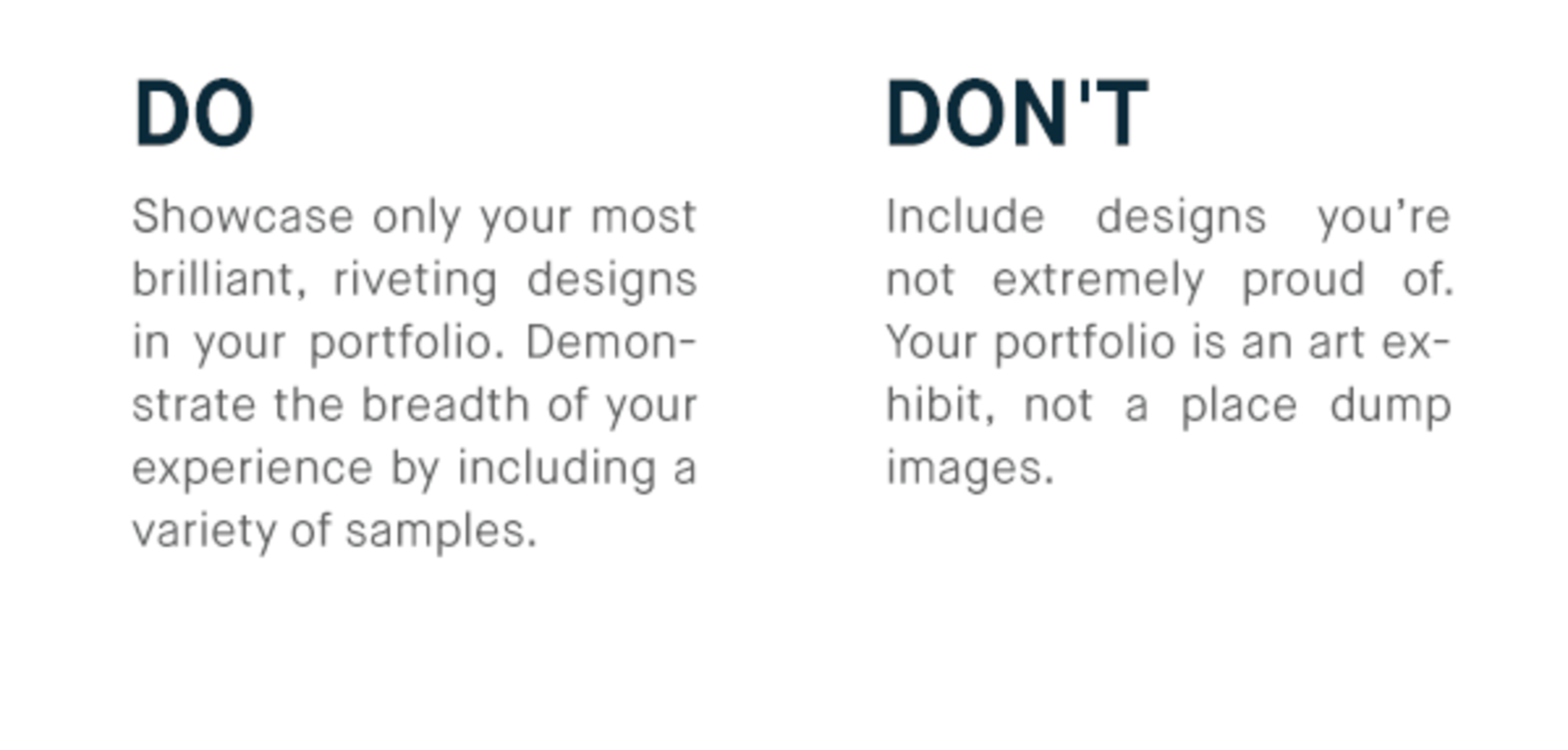
Tell the Story of Each Sample

Exhibiting your best designs doesn’t end with the images or screenshots. You’ve also got to show viewers what your designs achieved – and how.1 Imagine you’re a restaurant owner looking for a web designer with experience in the hospitality industry. You’ve narrowed it down to two people. Both have attractive restaurant websites in their portfolios, and you love what you see. However, one designer takes things a step further. Alongside each portfolio image, the designer explains the client’s goals and how the design achieved them. What’s more, the designer includes a detailed summary of the results from each project – clients can actually trace an uptick in business to the interaction patterns of the new design! Needless to say, _this_ is the person you want to design your new website. The lesson? Don’t just upload pretty pictures to your portfolio. Tell your audience the story behind your designs. You don’t have to turn every portfolio item into a case study, but you should always give viewers a sense of a design’s purpose and what it achieved for the organization that’s using it. Be sure each story covers:
Your role: Did you manage the whole project, or were you working as part of a larger team? Whatever the case, let viewers know where your efforts made the difference.
Your process: Tell viewers how you arrived at the design they see on the page. This is a good place to talk about the client’s goals and how you worked with them to address each one.
Success metrics: By what yardstick did you measure the design’s success? This could be as simple as determining whether the client was happy with the work (a glowing testimonial will help here!) or as complex as comparing customer acquisition rates between the old and new designs.
A clear story contextualizes your work and gives people a quantifiable reason to hire you. Ultimately, there’s a big difference between someone telling a decision maker, “I like this designer’s stuff” and “I like this designer’s work _and_ they’ve had success with organizations in our industry.” If you’re the designer with the better story, you’ll land the job.
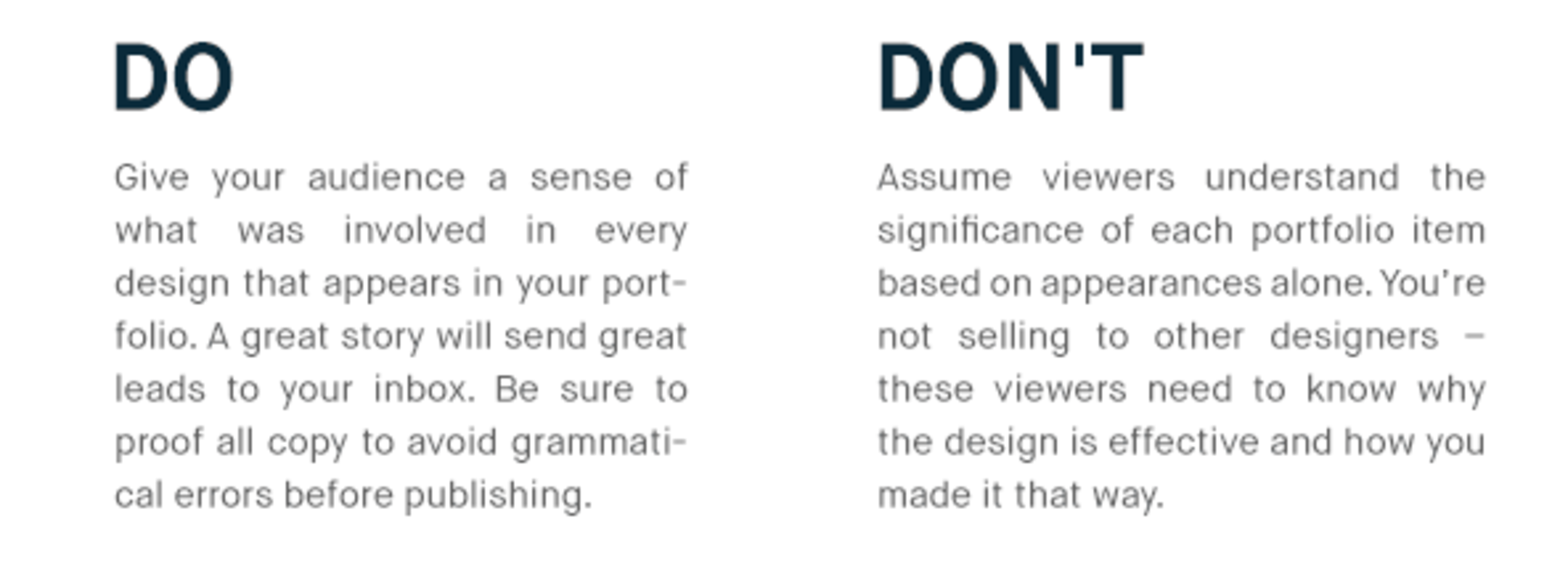
Choose a Web Platform
Picked out your most spellbinding design samples? Got a great story to accompany each piece? Excellent. The next step is choosing a web platform that makes browsing your portfolio easy and enjoyable. Your choice of platform will depend on your technical skill. Generally speaking, platforms that offer substantial flexibility in formatting and presentation may require some technical know-how like the ability to tweak HTML and CSS.2 On the other hand, platforms with out-of-the-box interfaces tend to be less customizable. That doesn’t make them less effective. It just means you have less freedom to change how your portfolio appears after selecting a platform. If you're a graphic or industrial designer with no coding experience, you might prefer a platform with requires no coding. However, if you have a web or UX background, your portfolio is a chance to show off your coding ability. Starting with the most straightforward, low-maintenance portfolio platforms, let’s explore your options:
Hosted portfolio websites
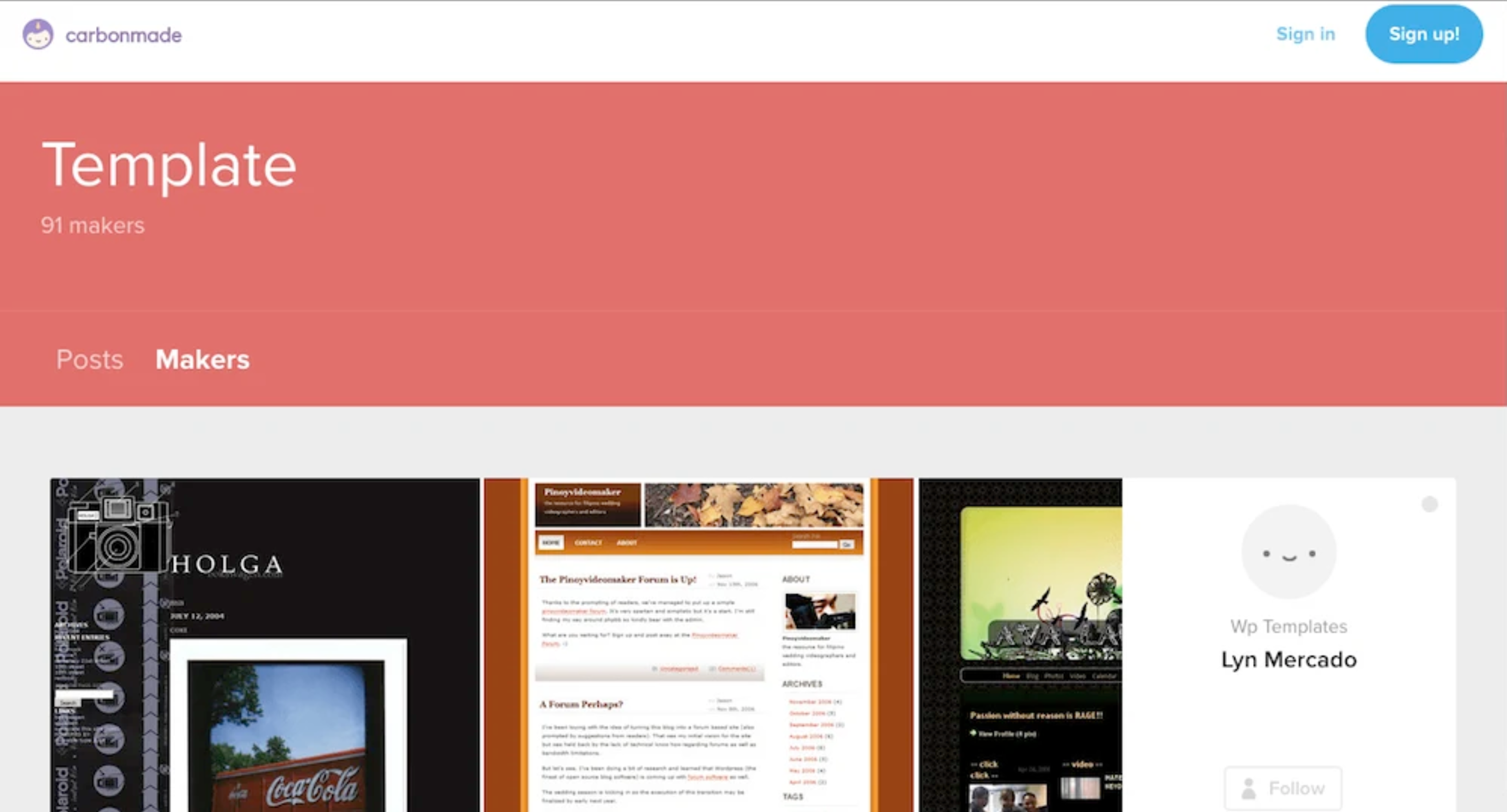
For many designers, the simplest option is a hosted portfolio website. If you don't want to write code, these are ideal options. Hosted platforms let you upload images and add content to a readymade layout. Typically, you’ll be able to choose from a variety of design portfolio templates, all of which offer a dedicated interface to highlight your work. “Hosted,” by the way, means you don’t have to purchase separate server space to store your portfolio. The platform takes care of it for you. Compare the following hosted platforms to see how they differ. All let you publish a beautiful, mobile-responsive portfolio at a nominal cost. Some even offer a free plan:
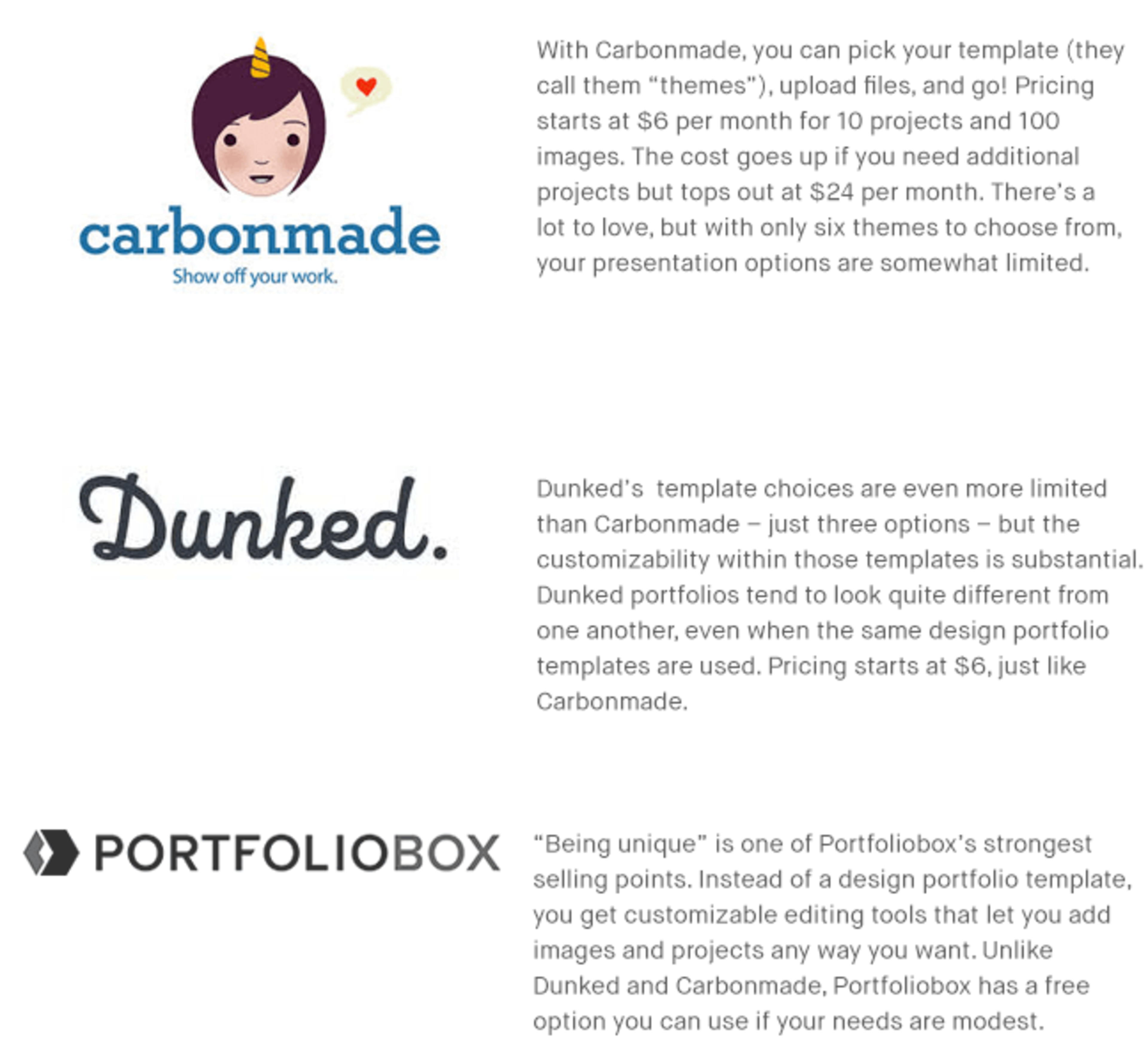
These certainly aren’t the only hosted portfolio sites out there. Check out Sessions College’s list of portfolio sites for more options.3 The important thing to remember is that all these hosted platforms make it easy to publish an attractive portfolio, even if you don’t have coding experience. And if you’re wondering why the above list omits some of the largest online design communities, there’s a good chance you’ll see them at Step 5, “Promote your work.”
Hosted business websites
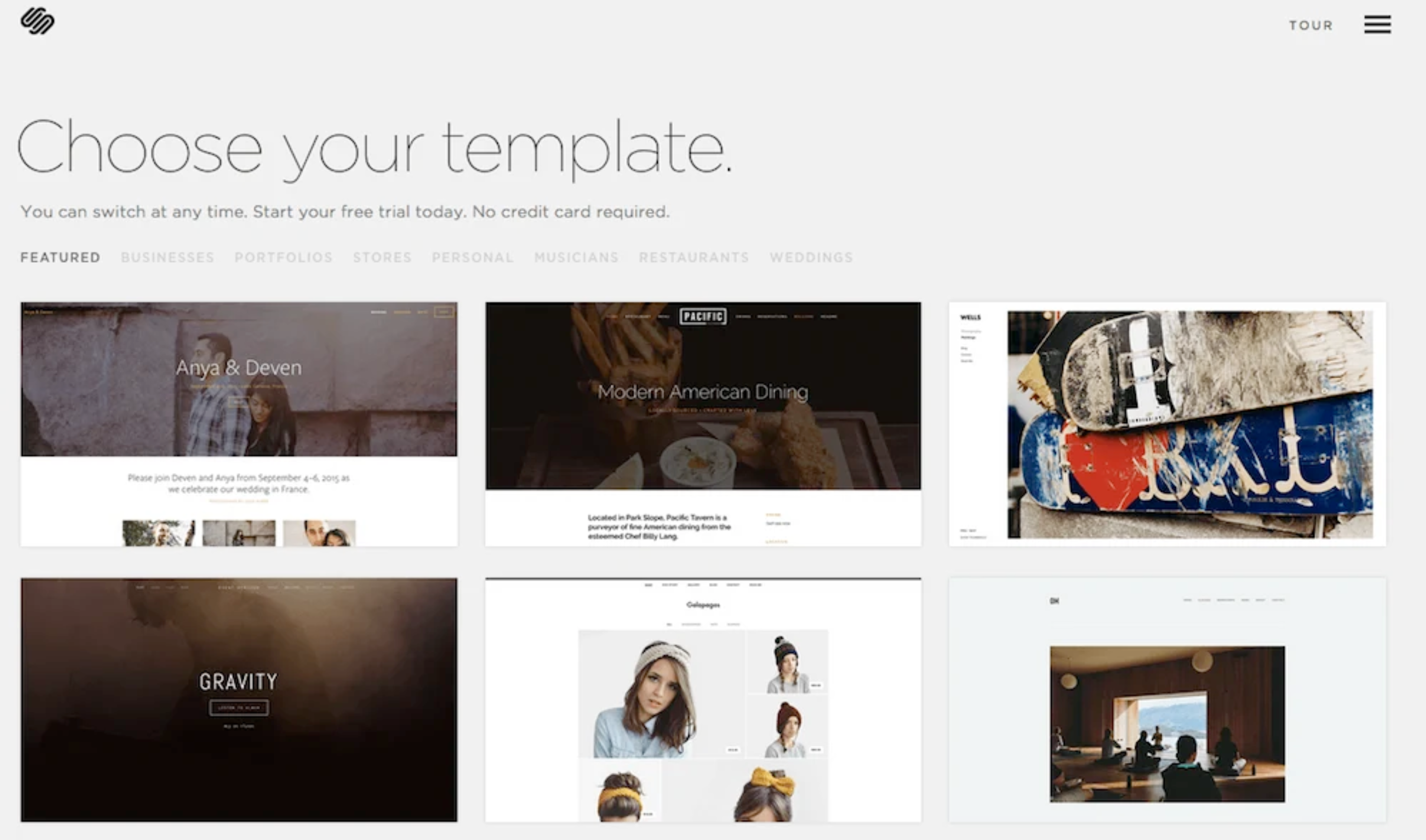
These are similar to hosted portfolio websites except they cater to businesses and publishers of all kinds – not just designers. All that means is that you have to scour the templates for portfolio-specific interfaces. Some of the most popular platforms include:
SquareSpace: With SquareSpace, you get 24/7 customer support, even with the least expensive $8 plan. Lots of businesses use SquareSpace, but the platform offers eight portfolio templates just for designers and creatives. After that, everything works a lot like the hosted portfolio websites: easy image uploads and content publishing, no programming knowledge needed.
Weebly: Like SquareSpace, Weebly targets various types of businesses. The platform offers a few themes for creatives, some of which have portfolio features. Not all Weebly themes are mobile responsive, although they do have a mobile display option that you can configure in the Weebly interface. If all you need is a simple portfolio without customer support, you can use Weebly for free.
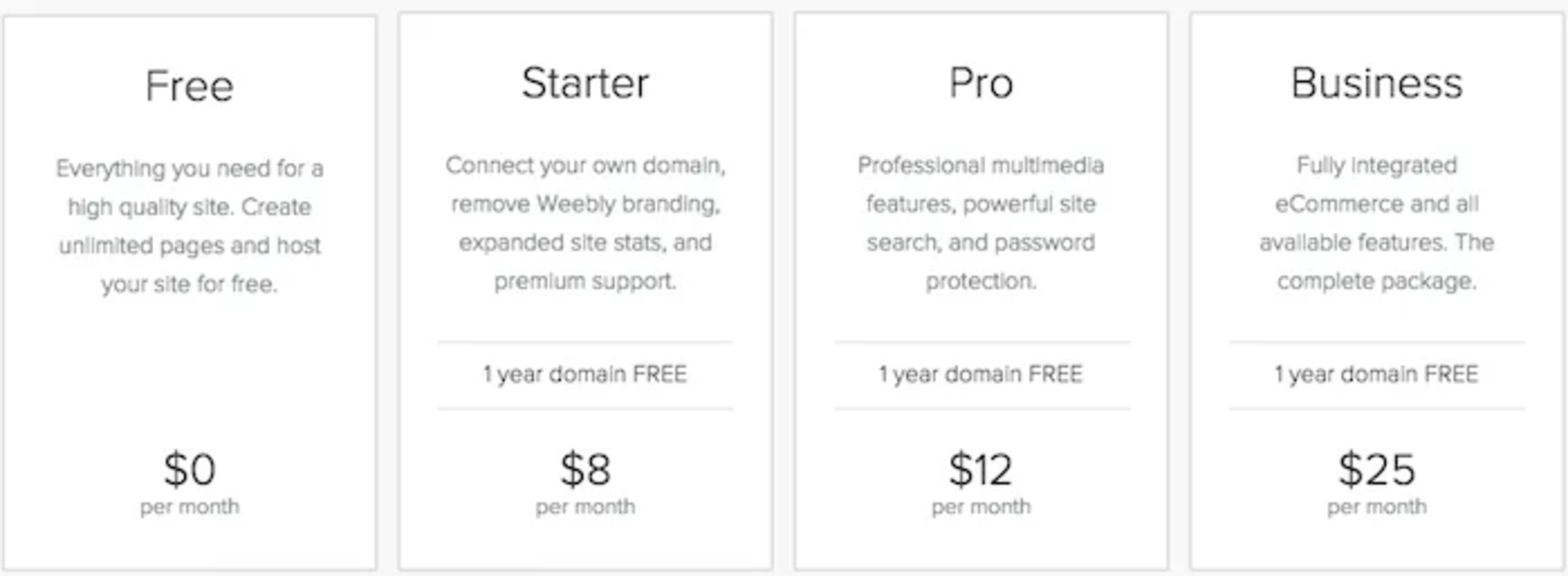
Source: Weebly.com\[/caption\]
Wordpress.com: Not to be confused with self-hosted WordPress websites (more on those in a bit), WordPress.com lets virtually any kind of publisher create a website from hundreds of different themes. You’ll have to search for “portfolio” to home in on themes that will work for you, but there are many to choose from. Unless you pick a theme labeled “premium,” WordPress.com is free.
These platforms give you an opportunity to customize your site's code, or leave it alone. If you want more control over your portfolio’s look and feel, and are willing to put in some coding work, you may prefer a self-hosted site.
Self-hosted websites
If you're creating a web design portfolio or want to show off some coding skills, you’re not limited to readymade templates and editors. You can publish a custom portfolio using a self-hosted website. There are only two catches:
1. You need to choose a web host.4 Hosted solutions take care of this step for you (hence the name), but “self-hosted” means you’re on your own.
2. If you can’t build the website from scratch - you still have to choose a platform.
And if you’re not going to code a website from the ground up, WordPress.org is the platform you should use for. Not WordPress.com, the hosted option, but the WordPress software you install on your own domain.5 It works a lot like WordPress.com – intuitive user interface, a variety of portfolio themes, free software – but with the added perk of access to a seemingly endless array of custom add-ons, or “plugins,” that you can tack onto your website. You can also access all of the code that powers your portfolio, which means you or a developer can customize the presentation to your liking. If you need the flexibility to publish a custom portfolio, are willing to take on the responsibility of hosting your own website, and want an opportunity to show off some coding knowledge, you might want to create your own site. For everyone else, a hosted platform probably makes the most sense. It also requires less maintenance, so you can spend more time creating beautiful designs.
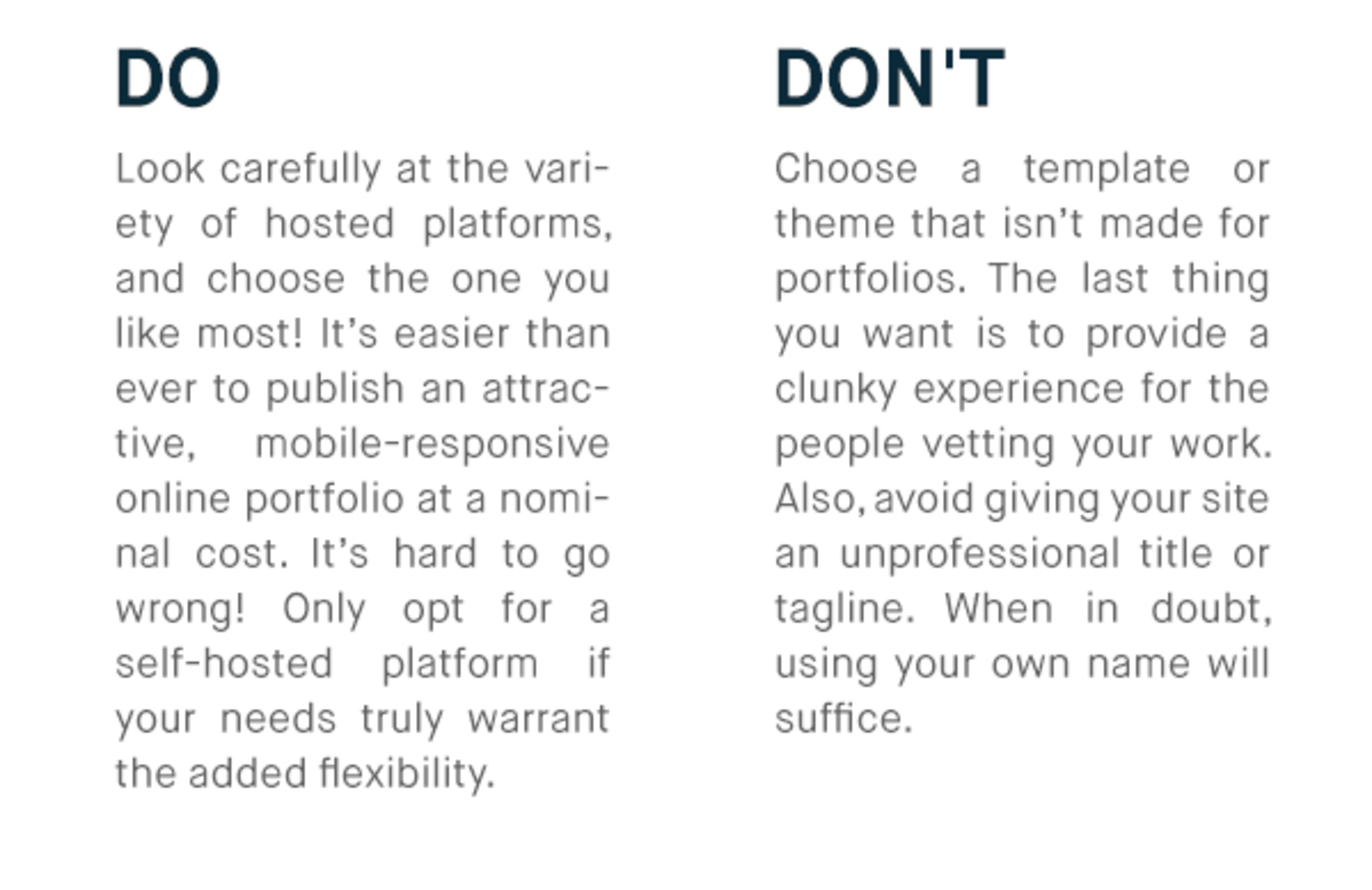
Optimize Your Website
Even the cleanest, most attractive portfolios will perform poorly without modest refinements. By optimizing your images and making it easy for your audience to contact you, you’ll bolster your portfolio website’s lead-generating potential. To ensure portfolio images don’t load sluggishly, remember to:
Resize images before uploading them to the web: Don’t make people load several thousand square pixels just to view a thumbnail. Resize every image to match the space in your template of choice. When in doubt, full-size images of 700 to 900 pixels wide are a safe bet for most users, most of the time.6
Compress every image: Even if you’re only using .jpg and .png files, you can usually shrink the file size without changing the image dimensions or sacrificing quality. Head over to TinyJPG and compress every image before uploading it to your platform.
Besides providing snappy load times, make sure your audience knows how to contact you when they want to get in touch. A clear call to action (for example, “Contact Me”) and an easy-to-use contact form will help make this happen. Be sure there’s a link to the form on every page of your site! Alternatively, you could just include your email address and phone number, but that means you’re counting on people to leave your site and use another application (or device) to contact you. Contact forms make you much more reachable.7 And yes, all of the platforms discussed in Step 3 offer contact form functionality. When it comes to website optimization:
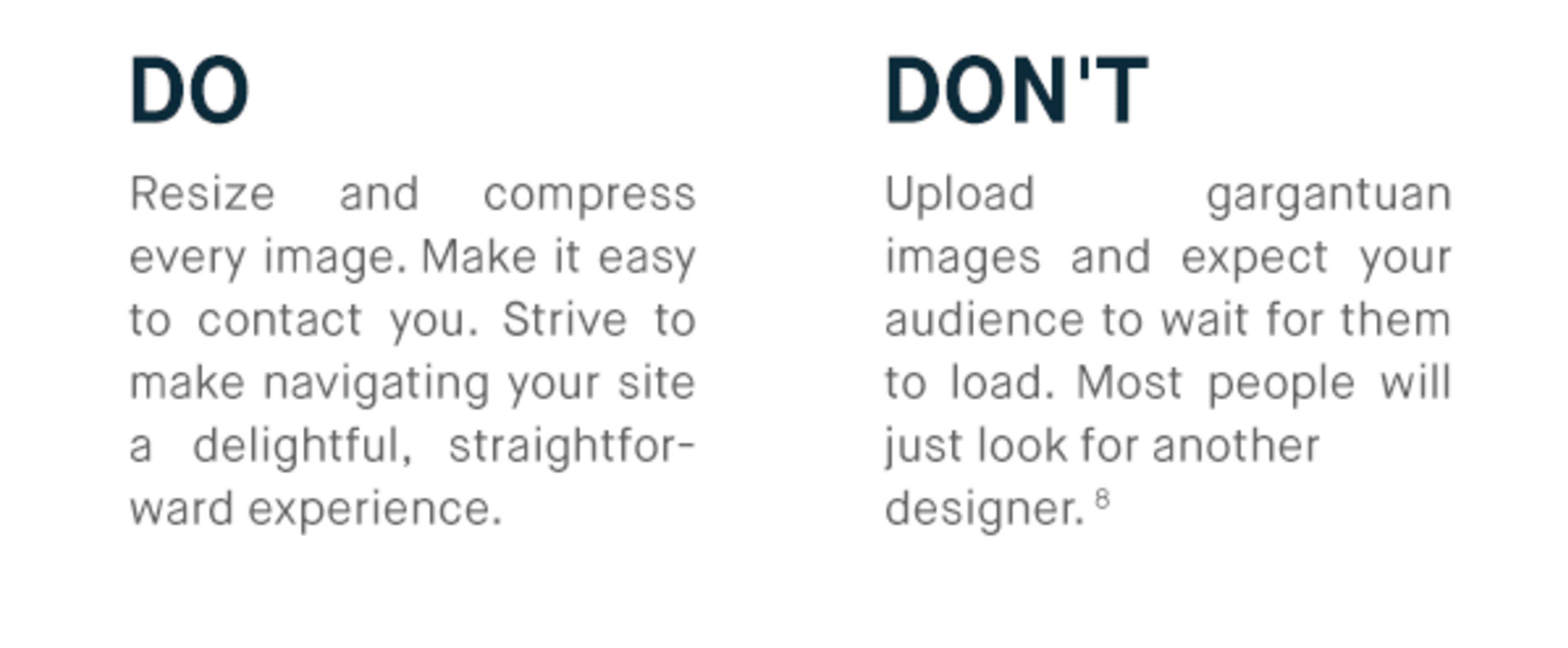
Promote Your Work
Though technically not a step in creating your online portfolio, promoting your work is key to maximizing the value of your efforts in Steps 1 through 4. A portfolio won’t help you if nobody looks at it! One way to promote your work is to join an online design community and share your achievements with other designers. These communities allow you to publish your work and receive feedback from other creatives. It’s a great way to network, and commentary from others can help you improve your work. At minimum, you should share your work with one out of the following three design communities, all of which boast thousands or, in some cases, millions of users:
Dribbble: The premise behind Dribbble is that it’s a place for designers to answer the question, “What are you working on?” The community is so popular that many businesses and agencies scour members’ “shots” and “buckets” for fresh design talent.9 It’s a way to network with other creatives and the people who hire them.
Anyone can follow, find, or hire designers on Dribbble, but to upload screenshots of your work you need an invitation from a current member. If you're looking to get "drafted," make sure you've marked yourself as a Prospect in your account settings!
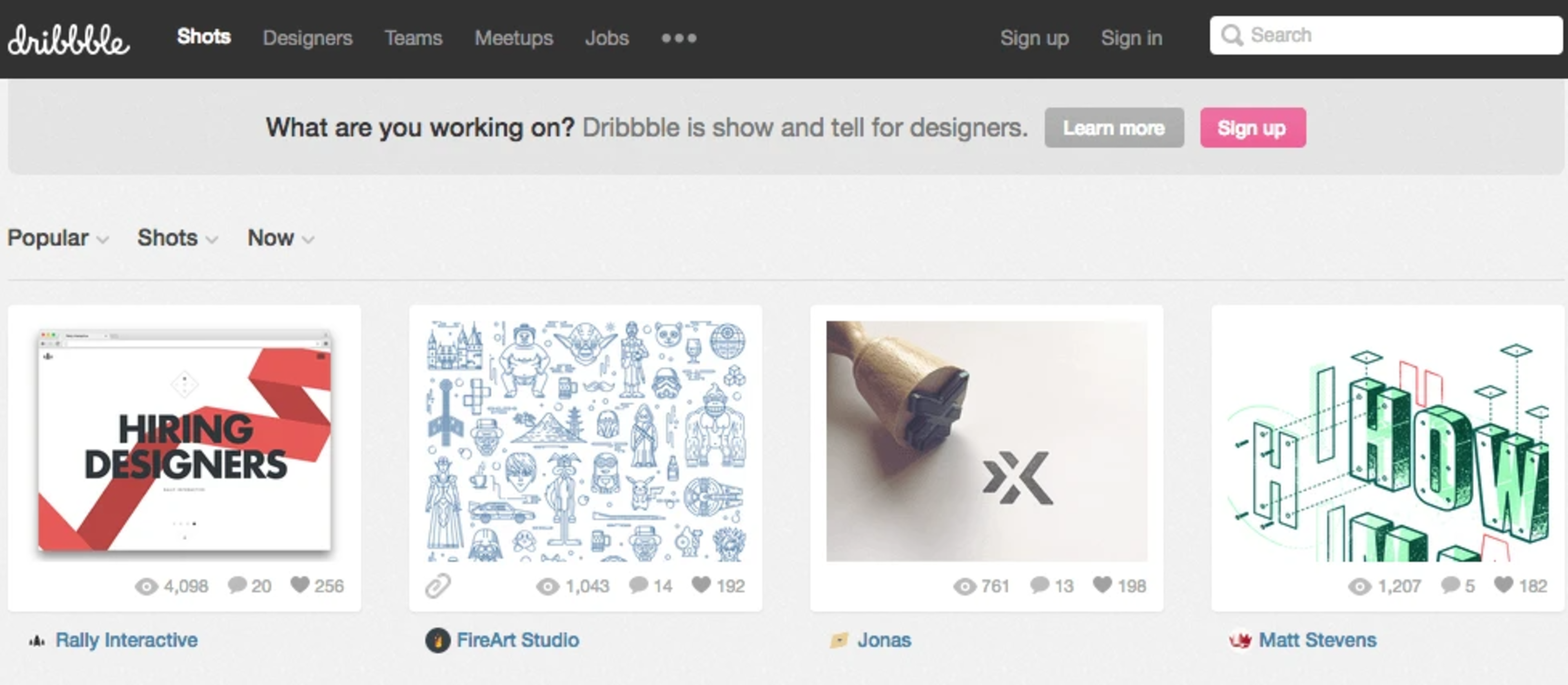
Behance: Behance is an Adobe-operated, non-exclusive project platform to show and share creative work. The concept is similar to Dribbble, but without the basketball theme or obstacles to upload your own work. It attracts tens of millions of visitors each month, with a larger variety of styles and works than Dribbble.
Each day, Behance curators go through every single uploaded project, and feature those works on the front page of the site. This is a fantastic opportunity to get your work widespread exposure.
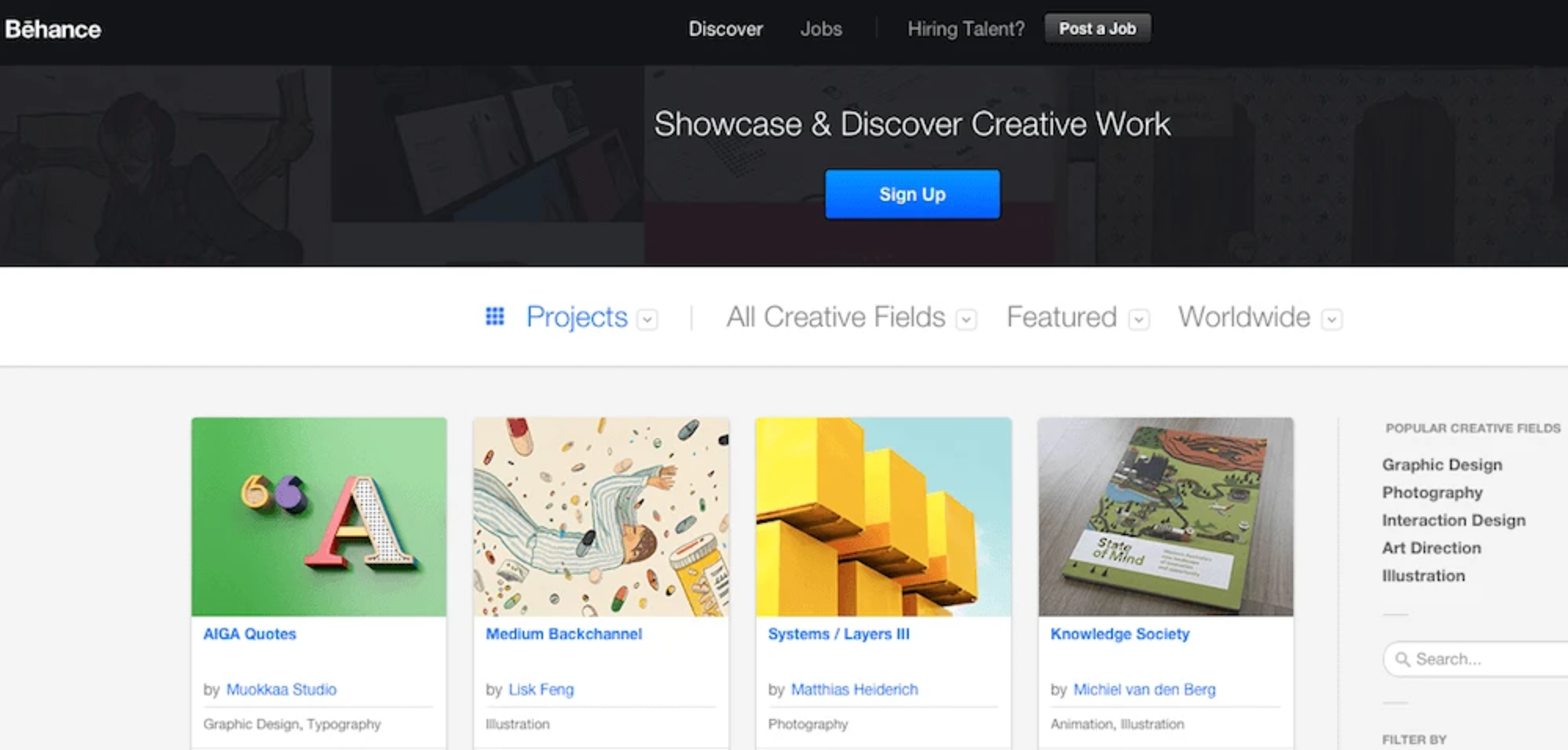
DeviantArt: One of the web’s oldest design communities, DeviantArt boasts more than 32 million registered members. Compared to Behance, its approach is more “art for art’s sake” than “designers for hire,” but that doesn’t diminish its potential as a place to connect with other creative minds.
All these websites provide a platform to showcase and promote your work. They shouldn’t replace your primary platform – they all let you link back to your website – but you can think of them as an ancillary portfolio you use to draw attention to your primary portfolio. Another way to promote your work is through social media. Let your Facebook friends and Twitter followers know you’ve published your portfolio on the web, and post new additions to your profile, feed, or artist page. 10 Remember: your friends want to see you succeed. If they know where to find your portfolio, they’re more likely to pass your name to a colleague who’s looking for a designer. Oh, and don’t forget to exploit one of the most credible methods of advertising: word-of-mouth promotion.11 Tell former and existing clients about your new portfolio, especially if you’re featuring their work. Let them know that you love referrals and they should feel free to show your portfolio to anyone looking for a designer. Seriously, it’s ok to ask. As long as you don’t repeatedly badger for, you won’t come across as desperate or overbearing. Instead, you’ll sound like an honest designer who’s looking for business, and there’s nothing wrong with that!

Conclusion
As you’re creating your online design portfolio, it’s important to remember what a portfolio is and isn’t. It isn’t a museum for all of your past projects, nor is it a sketchbook where you toss around new ideas. It’s a tool you use to make money. For individuals or organizations seeking design talent, your online portfolio proves you’re a professional, and able to create beautiful designs that help clients address business goals. The sooner you start thinking of your portfolio as a tool, the sooner it will deliver you new business!
Graham ShorrAuthor
Graham has worked in content marketing and strategy for Fortune 500 companies and niche brands in the Energy and Software industries. He graduated from Carnegie Mellon University with a degree in Professional Writing.
Sources
2. http://learn.shayhowe.com/html-css/
3. http://www.sessions.edu/notes-on-design/top-8-portfolio-sites-for-2014
4. http://www.wpbeginner.com/wordpress-hosting/
5. https://developer.wordpress.org/advanced-administration/before-install/howto-install/
6. http://blog.photoshelter.com/2011/01/10-secrets-to-successful-online-photo-portfolios/
7. http://www.unbounce.com/conversion-rate-optimization/how-to-optimize-contact-forms/
8. http://www.nytimes.com/2012/03/01/technology/impatient-web-users-flee-slow-loading-sites.html
10. http://www.huffingtonpost.com/carlota-zimmerman/how-artists-can-use-socia_b_4756824.html
11. http://www.entrepreneur.com/encyclopedia/word-of-mouth-advertising

